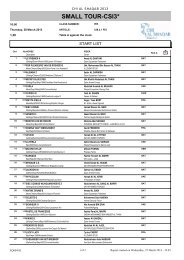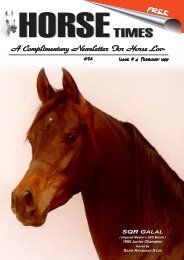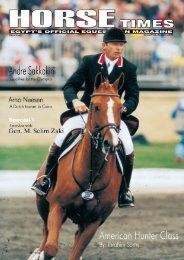Create successful ePaper yourself
Turn your PDF publications into a flip-book with our unique Google optimized e-Paper software.
Facts on Olympic history<br />
Olympic Motto<br />
The Olympic motto "Citius, Altius, Fortius" is Latin for "Faster, Higher, Braver," but is<br />
universally accepted to mean "Swifter, Higher, Stronger."<br />
Olympic Rings<br />
The Olympic symbol--five interlocked rings--represents the union of the five original<br />
major continents (Africa, America, Asia, Australia and Europe). The colors of the rings<br />
are thought to have been chosen because at least one of these colors can be found<br />
in the flag of every nation.<br />
Olympic Flag<br />
The Olympic Flag has a plain white background with no border. In the center are the five<br />
interlocked Olympic rings. The flag was presented by Baron Pierre de Coubertin in 1914<br />
at the Olympic Congress is 1914, celebrating the 20th anniversary of the founding of the<br />
International Olympic Committee<br />
At the Closing Ceremonies of the Olympic Games, the mayor of the Olympic host city<br />
presents the Olympic flag to the mayor of the next Olympic host city. The flag is then kept<br />
in the town hall of the host city until the next Olympic Games.<br />
Olympic Mascot (Lucky Charm)<br />
The first Olympic mascot made a discreet appearance at the 1968 Olympic Winter<br />
Games in Grenoble. Its name was Schuss. The Olympic mascot, however successful,<br />
disappears with the end of the Games it personifies. It was created to be understood<br />
by everyone, especially the young. It is friendly and appealing and is part of the visual<br />
identity of the Games.<br />
Olympic Creed<br />
The words of the Olympic Creed are attributed to Baron Pierre de Coubertin, the<br />
founder of the modern Olympic Games."The most important thing in the Olympic<br />
Games is not the win but to take part, just as the most important thing in life is not the<br />
triumph, but the struggle. The essential thing is not to have conquered but to have<br />
fought well."<br />
Olympic Games Torchbearers<br />
The idea of lighting an Olympic flame for the duration of the Games derives from the<br />
ancient Greeks who used a flame lit by the sun’s rays at Olympia, Greece, the site<br />
of the original Games. The concept was revived at the 1936 Olympic Games in<br />
Berlin and has remained an Olympic tradition.<br />
Victory Ceremonies<br />
Olympic medals must be at least 66 mm in diameter and at least three mm<br />
thick. Gold & silver medals must be made of 92.5 percent pure silver; the gold<br />
medal must be gilded with at least six grams of gold. The design of the medals<br />
is the responsibility of the host city.<br />
At the first modern Games in Greece, 1896, medals were given only to first<br />
& second-place. The winner received a silver medal & the runner-up a bronze<br />
medal. The winner was also given a crown of olive branches, while the secondplace<br />
finisher settled for a laurel branch crown. The 1900 Games in Paris remain<br />
the only Olympics where winners were only given valuable pieces of art.<br />
Opening Ceremonies<br />
Planning and execution of this ceremony is the responsibility of the host city,<br />
but basic guidelines, as outlined in the Olympic Charter of 1985, exist.<br />
Athletes parade into the main Olympic stadium in alphabetical order according<br />
to the host country’s language with two exceptions: Greece, which hosted<br />
the first modern Games in 1896, always leads the parade, and the host<br />
country’s team is always last.<br />
The president of the IOC asks the host country’s Head of State to open the<br />
Games. The Head of State does the honors with the following phrase: "I declare<br />
open the Games of (host city), celebrating the (number of the) Olympiad of the<br />
modern era."<br />
Closing Ceremonies<br />
The closing ceremony, also held in the main Olympic stadium, signals the<br />
of ficial end of the Games. Olympic protocol requires each country to select a<br />
standard bearer. The athletes march in no particular order, between eight and<br />
10 abreast,<br />
"united only by the friendly bonds of Olympic sport."<br />
As the Greek national anthem is played, its flag is raised to the right of the center<br />
flagpole. Then the flag of the next host country is raised to the left.<br />
The IOC president then pronounces the Games closed with the following<br />
statement: "I call upon the youth of all countries to assemble four years from<br />
now at (the site of the next Olympics), there to celebrate with us the Games of<br />
the (number of the next) Olympiad." Then the Olympic Flame is extinguished The<br />
Olympic Flag is then lowered and carried from the stadium by eight people.<br />
Olympic Oath<br />
The Olympic Oath is a symbolic gesture of sportsmanship that began at the 1920<br />
Olympic Games in Antwerp, Belgium. Basically, one athlete from the host country<br />
takes an oath in the Opening Ceremonies on behalf of all athletes. The oath is as follows:<br />
"In the name of all competitors, I promise that we shall take part in these Olympic<br />
Olympics; Athens2004<br />
Otto Becker on Cento<br />
Andrew Hoy on Mr. Pracatan, fall<br />
at an obstacle.<br />
Sep. HORSE <strong>Times</strong> 15














